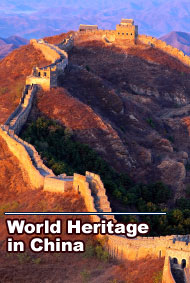
|
|
|
Classical Gardens of Suzhou (Suzhou City, Jiangsu Province)
a. Brief Introduction As outstanding examples of southern China's private gardens, Suzhou's classical gardens are noted for their exquisite design and layout. Landscape and buildings are perfectly integrated, to create a great harmony between man and nature. Thanks to careful protection and good management, several of the gardens have been included in the UNESCO World Heritage List, including Zhuozhen Garden(Humble Administrator's Garden), Wangshi Garden(Master-of-Nets Garden), Liuyuan Garden(Lingering Garden), Huanxiu Villa(Villa with Embraced Beauty) , Canglangting Garden(Surging Waves Pavilion), Shizilin Garden(Lion Forest Garden), Ouyuan Garden (Double Courtyard), Yipu Garden (Art Garden) and Tuisi Garden(Retreat and Reflection Garden). These gardens demonstrate the typical features of Suzhou's classical gardens in layout, structure, design, style, use of color, decoration and furniture. Suzhou's classical gardens occupy a unique and irreplaceable position in the history of world landscape gardening, and have high value for the study of Chinese landscape gardening, architecture, culture, aesthetics, philosophy and folklore. b. Cultural Heritage Canglangting Garden (Surging Waves Pavilion) Canglangting Garden has the longest history among all the existing classical gardens in Suzhou. Naturally laid out and well designed, it is called one of the four best gardens in Suzhou---the other three are Shizilin, Zhuozhen and Liuyuan.The garden looks simple but natural. Without contrived decorations, it combines buildings with scenery so perfectly that the whole garden appears to be naturally endowed. The garden is built along a small pond. In front of its north gate, there is a stone bridge. Entering the garden, you can see a yellow rockery. Behind it, there is an artificial hill made of stone and earth. Vigorous is naturally made, properly arranged, and appears steep and magnificent. Since there is a courtyard on each side of the garden, it is named Ouyuan, meaning double courtyard. Yipu Garden (Art Garden) This garden has an expansive view and a simple style. Since many of the original features of the garden have been preserved, the garden has a high historical and artistic value. Occupying an area of five mu (one mu equals 0.07 ha), the garden is built around a pond with stone bridges over it. Most of the buildings are constructed in the north, among which the Buoya Hall is the main hall of the garden. To its south there is a small courtyard with a rock terrace in a pond. To the south of the courtyard are built five water pavilions. And to the south of the pond there is an artificial hill. The side of the hill along the pond is steep, with precipitous paths. To the south of the pond there is the Ruyou Pavilion, dating from the Ming Dynasty, which is connected with the outside by paths. To the west of the pond is located Qinlu Courtyard, which is entered by a round moon gate. Inside the courtyard there is a small pond linked with the main pond outside. Such a design is unique among Suzhou's classical gardens. Tuisi Garden (Retreat and Reflection Garden) Built between 1885 and 1887, the garden looks delicate, simple and elegant. It is a masterpiece among southern China's private gardens. c. Suzhou-style Bonsai As one of China's major schools of miniature trees, Suzhou-style bonsai is famous for its long history, unique design and distinctive style. Thanks to favorable natural conditions, skilled artisans have long since created bonsai masterpieces to record natural scenery in tiny pots. In addition, the rich culture of the city adds special flavor and a unique style to Suzhou-style bonsai. Suzhou bonsai is noted for its plainness and elegance. Old twigs aged 40, 60 or even 100 years are planted in a small plate and presented in different shapes -- drooping, prostrate, looking up or bending down. |